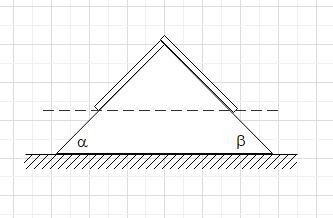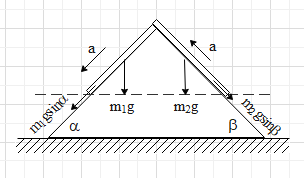
A uniform rope of length L and mass M is placed on a smooth fixed wedge as shown. Both ends of rope are at the same horizontal level. The rope is initially released from rest, then the magnitude of initial acceleration of the rope is


Answer
572.7k+ views
Hint: To solve this question, first find the component of the forces acting on the ropes on both sides and then equate them to find the equation. Add the equations for both sides of the rope to find the initial acceleration acting on the rope.
Complete step-by-step answer:
The length of the rope on the left side is ${{L}_{1}}$ and on the right side is ${{L}_{2}}$. The total length of the rope is L.
$L={{L}_{1}}+{{L}_{2}}$
Total mass of the rope is M.
The mass per unit length of the rope is $\dfrac{M}{L}$
So, the mass of the rope on the left side is ${{m}_{1}}={{L}_{1}}\dfrac{M}{L}$
Mass of the rope on the right side is ${{m}_{2}}={{L}_{2}}\dfrac{M}{L}$

Weight of the rope on the left side is, ${{m}_{1}}g=\dfrac{{{L}_{1}}M}{L}g$
Weight of the rope on the right side is, ${{m}_{2}}g=\dfrac{{{L}_{2}}M}{L}g$
Now, taking the component of the forces on the ropes,
On the left side of the rope,
$\begin{align}
& {{m}_{1}}g\sin \alpha -T={{m}_{1}}a \\
& \dfrac{{{L}_{1}}M}{L}\sin \alpha -T=\dfrac{{{L}_{1}}M}{L}a \\
\end{align}$
And, on the right side of the rope,
$\begin{align}
& T-{{m}_{2}}g\sin \beta ={{m}_{2}}a \\
& T-\dfrac{{{L}_{2}}M}{L}g\sin \beta =\dfrac{{{L}_{2}}M}{L}a \\
\end{align}$
Adding the above two equations,
$\begin{align}
& \dfrac{{{L}_{1}}M}{L}g\sin \alpha -\dfrac{{{L}_{2}}M}{L}g\sin \beta =\dfrac{{{L}_{1}}M}{L}a+\dfrac{{{L}_{2}}M}{L}a \\
& \left( {{L}_{1}}\sin \alpha -{{L}_{2}}\sin \beta \right)g=\left( {{L}_{1}}+{{L}_{2}} \right)a=La \\
& a=\dfrac{\left( {{L}_{1}}\sin \alpha -{{L}_{2}}\sin \beta \right)g}{a} \\
\end{align}$
Now, since both ends of the rope are in the same horizontal line or in the same vertical height, the components,
${{L}_{1}}\sin \alpha ={{L}_{2}}\sin \beta $
So, we can write,
$a=0$
So, the correct answer is “Option A”.
Note: In the above question, the angles of the triangle are different from each other and also the lengths of the rope on the both sides are also different. But then also the components in the vertical directions are equal to each other because the both ends of the rope are in the same horizontal plane or in the same vertical height.
Complete step-by-step answer:
The length of the rope on the left side is ${{L}_{1}}$ and on the right side is ${{L}_{2}}$. The total length of the rope is L.
$L={{L}_{1}}+{{L}_{2}}$
Total mass of the rope is M.
The mass per unit length of the rope is $\dfrac{M}{L}$
So, the mass of the rope on the left side is ${{m}_{1}}={{L}_{1}}\dfrac{M}{L}$
Mass of the rope on the right side is ${{m}_{2}}={{L}_{2}}\dfrac{M}{L}$

Weight of the rope on the left side is, ${{m}_{1}}g=\dfrac{{{L}_{1}}M}{L}g$
Weight of the rope on the right side is, ${{m}_{2}}g=\dfrac{{{L}_{2}}M}{L}g$
Now, taking the component of the forces on the ropes,
On the left side of the rope,
$\begin{align}
& {{m}_{1}}g\sin \alpha -T={{m}_{1}}a \\
& \dfrac{{{L}_{1}}M}{L}\sin \alpha -T=\dfrac{{{L}_{1}}M}{L}a \\
\end{align}$
And, on the right side of the rope,
$\begin{align}
& T-{{m}_{2}}g\sin \beta ={{m}_{2}}a \\
& T-\dfrac{{{L}_{2}}M}{L}g\sin \beta =\dfrac{{{L}_{2}}M}{L}a \\
\end{align}$
Adding the above two equations,
$\begin{align}
& \dfrac{{{L}_{1}}M}{L}g\sin \alpha -\dfrac{{{L}_{2}}M}{L}g\sin \beta =\dfrac{{{L}_{1}}M}{L}a+\dfrac{{{L}_{2}}M}{L}a \\
& \left( {{L}_{1}}\sin \alpha -{{L}_{2}}\sin \beta \right)g=\left( {{L}_{1}}+{{L}_{2}} \right)a=La \\
& a=\dfrac{\left( {{L}_{1}}\sin \alpha -{{L}_{2}}\sin \beta \right)g}{a} \\
\end{align}$
Now, since both ends of the rope are in the same horizontal line or in the same vertical height, the components,
${{L}_{1}}\sin \alpha ={{L}_{2}}\sin \beta $
So, we can write,
$a=0$
So, the correct answer is “Option A”.
Note: In the above question, the angles of the triangle are different from each other and also the lengths of the rope on the both sides are also different. But then also the components in the vertical directions are equal to each other because the both ends of the rope are in the same horizontal plane or in the same vertical height.
Recently Updated Pages
Master Class 11 Economics: Engaging Questions & Answers for Success

Master Class 11 English: Engaging Questions & Answers for Success

Master Class 11 Social Science: Engaging Questions & Answers for Success

Master Class 11 Biology: Engaging Questions & Answers for Success

Class 11 Question and Answer - Your Ultimate Solutions Guide

Master Class 11 Business Studies: Engaging Questions & Answers for Success

Trending doubts
10 examples of friction in our daily life

One Metric ton is equal to kg A 10000 B 1000 C 100 class 11 physics CBSE

Difference Between Prokaryotic Cells and Eukaryotic Cells

1 Quintal is equal to a 110 kg b 10 kg c 100kg d 1000 class 11 physics CBSE

Explain zero factorial class 11 maths CBSE

What is a periderm How does periderm formation take class 11 biology CBSE




